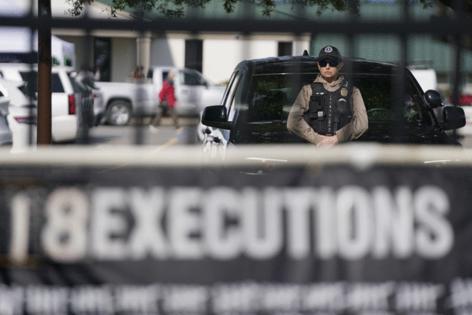Cop-killer called 'evil' is second to die by firing squad in South Carolina
Published in News & Features
COLUMBIA, S.C. — At 6:01 p.m. Friday, in a crack of rifle shots, Mikal Mahdi was executed inside of the Broad River Road Correctional Institution in Columbia, South Carolina. The convicted double murder let out a groaning yell as the bullets struck his chest, followed 80 seconds later by a deep guttural moan as the life seemed to leave him. He was pronounced dead around 6:05 p.m.
“There was some agony in the cries,” said Jeffrey Collins with the Associated Press. Collins, who has witnessed 12 executions, said that it was the first time he had heard an audible expression of pain from a condemned person.
Mahdi was sentenced to death following a 2004 crime spree across five states. In Winston Salem, North Carolina, Mahdi shot and killed Christopher Boggs, a gas station clerk before ambushing and executing Orangeburg Department of Public Safety Capt. James Myers at his home in Calhoun County. Mahdi was sentenced to death for Myers’ murder after pleading guilty in 2006. He was also serving a life sentence for Boggs’ murder.
Mahdi chose to die by firing squad, making him just the second person in South Carolina to select that method of execution. He was just the fifth person in the United States executed by firing squad since 1976, when the U.S. Supreme Court reinstituted the death penalty.
Mahdi is the second person on South Carolina’s death row to choose to die by firing squad. In March, Brad Sigmon, who was sentenced to death for the murders of his ex-girlfriend’s parents, also chose to die by firing squad.
Both men chose the firing squad as concern has grown over South Carolina’s secretive lethal injection protocol, one of the other methods of execution along with the electric chair. Lawyers for both have said that autopsies showed fluid in the lungs of two inmates executed using the state’s pentobarbital protocol. This is evidence of a pulmonary edema, which lawyers say might cause excruciating pain similar to drowning.
Mahdi was served his last meal on Wednesday evening: a ribeye steak cooked medium, mushroom risotto, broccoli, collard greens, cheesecake and sweet tea.
On Friday afternoon, the U.S. Supreme Court declined to take up Mahdi’s appeal, and around 6 p.m., Gov. Henry McMaster declined to issue a pardon.
In addition to Collins, two other members of the media were in attendance: Martha Rose Brown from the Orangeburg Times and Democrat and Brian McConchie with WACH-Fox in Columbia. Also in attendance was Mahdi’s attorney, David Weiss, a representative of the First Circuit Solicitors Office, which prosecuted the case, Calhoun County Sheriff Thomas Summers and an unidentified member of Myers’ family.
The curtain separating the death chamber from the witness room rose shortly before 6 p.m., according to the media witnesses. Mahdi, dressed in black with a white target on his chest, was strapped to a metal chair with a leather strap holding his head in place. Witnesses say that he stared straight forwards, not acknowledging anyone in the witness room. He gave no final statement before a hood was placed over his head.
At 6:01 p.m., shots were fired with no warning from gun ports in the walls, witnesses say. Mahdi made a noise somewhere between a yell and a groan as the three .308 rounds hit him in the chest, according to witnesses. The white paper target appeared to be sticking out of the wound in his chest, said Collins. Over the next 80 seconds, he gave several short breaths and moaned twice again before giving a final deep gasp. Seconds later a doctor examined Mahdi with a stethoscope and pronounced him dead at 6:05 p.m..
Mahdi is the fifth person to be executed in South Carolina since the state resumed executions in September 2024.
From the ages of 14 to 21, Mahdi was largely confined in either juvenile detention or prison. During that time he spent 10 months in solitary confinement.
The deadly crime spree began only months after Mahdi was released from prison. Just days before murdering Myers, Mahdi left his home in Virginia. Driving through North Carolina, Mahdi shot and killed Boggs, a gas station clerk, over a can of beer. He then carjacked a vehicle in Columbia, South Carolina, before fleeing to Calhoun County.
Mahdi ambushed Myers, 56, as the officer returned from celebrating his daughter’s birthday at the beach. Mahdi, 21 at the time, was hiding in a shed on Myers’ property in Calhoun County.
First Circuit Solicitor David Pascoe, who tried Mahdi, described him as “evil,” with “no regard for human life,” while Mahdi’s defense attorneys argued he was psychologically damaged by an abusive childhood compounded by long periods of isolation.
Mahdi shot Myers, a 30-year veteran firefighter and law enforcement officer, repeatedly with a rifle before setting his body on fire and fleeing with the police officer’s guns. Myers’s body was discovered by his wife the next day.
When Mahdi was caught following a manhunt in Satellite Beach, Florida, he told arresting officers that the only reason he hadn’t shot them was he believed that he wouldn’t be able to kill them all.
Violence followed Mahdi in prison. In 2009, Mahdi and another inmate stabbed a death row guard with improvised metal knives. The guard survived the stabbing, which took place inside of the Lieber Correctional Institution in Ridgeville.
In an opinion upholding Mahdi’s sentence in a previous appeal, state Supreme Court Justice Jean Toal wrote, “in my time on this Court, I have seen few cases where the extraordinary penalty of death was so deserved.”
Sentencing judge never heard childhood trauma, attorneys say
But before his senseless murders, Mahdi lived a life defined by instability, violence and institutionalization.
For much of his childhood he was under the control of his father, Shareef Mahdi, a violent schizophrenic who hated white people and who beat his sons, forced them to live in the woods with him and conducted survivalist drills to prepare them to fight a coming “New World Order,” according to court filings.
From a young age, Mahdi expressed a desire to kill himself. Sent to a psychiatric facility at the age of 9, Mahdi said he wanted to shoot himself with a gun or a bow and arrow, according to legal filings.
In an affidavit, his third grade teacher said that Mahdi was a “withdrawn” child who slowly flourished when away from his family. He began to express an interest in art and poetry, the teacher said.
But as he grew older, Mahdi fell into first the juvenile and then the adult justice systems. He racked up disciplinary infractions, which his attorneys argued were often normal acts of teenage rebellion, like refusing to tuck in his shirt, participate in exercise or stand up when guards conducted morning counts. But this led to him being sentenced to months in solitary confinement.
During a period after Mahdi was released at the age of 16, his father refused to take him to court hearings leading to a standoff with police.
In last minute appeals, his attorneys said that new research on impacts of isolation on brain development indicate that Mahdi was deeply traumatized by these long periods of isolation during his adolescence.
In 2016, President Barack Obama signed an executive order banning the use of solitary confinement on juveniles in the federal prison system citing the potential for “devastating, lasting psychological consequences.”
But this evidence was never presented to Judge Newman. Mahdi’s lawyers say that his original legal team put up a defense that lasted barely 30 minutes.
“Things just went sideways in a really bad way at his trial,” attorney David Weiss, a federal public defender who represented Mahdi, told The State.
In filings, Weiss and Mahdi’s other attorneys argued that his original trial lawyers were poorly equipped to handle a death penalty trial. Mahdi pleaded guilty after being caught with a homemade handcuff key. The sentencing phase of his trial was conducted without a jury in front of Newman, who oversaw the murder trial of former Hampton County attorney Alex Murdaugh, who was convicted for killing his wife and son.
Defending a death penalty case is unique, Weiss said, because the questions are often not whether the person killed someone, but whether death is right punishment.
“It requires a little bit more of a human understanding and just how a person’s experiences shape who they are,” Weiss said. This includes a specialized understanding of family dynamics including mental health history within families, as well as the impact of systems, like prison and mental health institutions, on an individual.
In the early 2000s, many of the attorneys appointed to represent indigent defendants in death penalty trials lacked this specialized knowledge, Weiss said. In 2008, two years after Mahdi’s trial and a year after the General Assembly passed reforms to the public defender system, South Carolina’s Commission on Indigent Defense formed the Capital Trial Division to argue death penalty cases.
Since then, only four people have been sent to death row, according to the South Carolina Association of Defense Lawyers.
While the state unofficially suspended executions in 2013 when it ran of the drugs needed for lethal injections, the defense association argued in a legal filing supporting Mahdi’s appeal that had the Capital Trial Division existed in 2006, “there is every reason to believe Mr. Mahdi would have benefited from a comprehensive mitigation investigation, resulting in a robust presentation of mitigating evidence.”
“Folks who are put on capital trials have gone through extraordinary trauma in their lives, and that hurt that they’ve experienced then tragically gets acted out onto other people and causes tremendous pain to victims and their families. Our job is just to try and help people to understand that,” Weiss said. “Our clients can and should be punished very, very harshly, but their lives don’t need to be taken.”
©2025 The State. Visit thestate.com. Distributed by Tribune Content Agency, LLC.







Comments